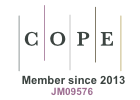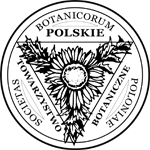Macrofungi on Three Nonnative Coniferous Species Introduced 130 Years Ago, Into Warmia, Poland
Abstract
Keywords
References
Bellon, S., Tumiłowicz, J., & Król, S. (1977). Obce gatunki drzew w gospodarstwie leśnym [Foreign species of trees in a forest management]. Państwowe Wydawnictwo Rolnicze i Leśne.
Benben, K. (1969). Z badań nad chorobami drzew północnoamerykańskich aklimatyzowanych w Polsce [Studies on diseases of North American tree species acclimatized in Poland]. Prace Instytutu Badawczego Leśnictwa, 373–375, 129–144.
Bernicchia, A. (2005). Polyporaceae s. l. Edizioni Canduso.
Bernicchia, A., & Gorjón, S. P. (2010). Corticiaceae s. l. Edizioni Candusso.
Białobok, S., & Chylarecki, H. (1965). Badania nad uprawą drzew obcego pochodzenia w Polsce w warunkach środowiska leśnego [Investigation on growing foreign trees in Polish forests]. Arboretum Kórnickie, 10, 211–277.
Bollen, W. B., Chen, C. S., Lu, K. C., & Tarrant, R. F. (1968). Effect of stem flow precipitation on chemical and microbiological soil properties beneath a single alder tree. In J. M. Trappe, J. F. Franklin, R. F. Tarrant, & G. M. Hansen (Eds.), Biology of alder. Proceedings of Northwest Scientific Association Annual Meeting, April 14–15, 1967 (pp. 149–156). Forest and Range Experiment Station.
Breitenbach, J., & Kränzlin, F. (1984). Fungi of Switzerland. Vol. 1. Ascomycetes. Verlag Mykologia.
Breitenbach, J., & Kränzlin, F. (1986). Fungi of Switzerland. Vol. 2. Non gilled fungi. Heterobasidiomycetes, Aphyllophorales, Gastromycetes. Verlag Mykologia.
Breitenbach, J., & Kränzlin, F. (1991). Fungi of Switzerland. Vol. 3. Boletes and agarics (Part 1). Strobilomycetaceae and Boletaceae, Paxillaceae, Gomphidiaceae, Hygrophoraceae, Tricholomataceae, Polyporaceae (lamellate). Verlag Mykologia.
Breitenbach, J., & Kränzlin, F. (1995). Fungi of Switzerland. Vol. 4. Boletes and agarics (Part 2). Entolomataceae, Pluteaceae, Amanitaceae, Agaricaceae, Coprinaceae, Bolbitiaceae, Strophariaceae. Verlag Mykologia.
Breitenbach, J., & Kränzlin, F. (2000). Fungi of Switzerland. Vol. 5. Boletes and agarics (Part 3). Cortinariaceae. Verlag Mykologia.
Butin, H. (1995). Tree diseases and disorders: Causes, biology, and control in forest and amenity trees. Oxford University Press.
Chylarecki, H. (1976). Badania nad daglezją w Polsce w różnych warunkach ekologicznych [Research of Douglas fir in Poland in various ecological conditions]. Arboretum Kórnickie, 21, 15–124.
Cieślak, R., Łakomy, P., & Molińska-Glura, M. (2011). Description of Heterobasidion annosum sensu stricto population occurring in Scots pine stands in Człopa and Podanin Forest Districts. I. Mycelium development in alive wood. Acta Scientiarum Polonorum Silvarum Colendarum Ratio et Industria Lignaria, 10(3), 15–25.
Cyzman, W., Barcikowski, A., & Wojciechowska, A. (2012). Wpływ nasadzeń obcych gatunków drzew na strukturę syntaksonomiczną zbiorowisk leśnych [Impact of planted alien tree species on the syntaxonomical structure of forest communities]. Studia i Materiały CEPL, 33(4), 259–269.
Danckelmann, B. (1884). Anbauversuche mit ausländischen Holzarten in den Preußischen Staatsforsten [Trials with foreign wood species in the Prussian state forest]. Zeitschrift für Forst- und Jagdwesen, 6–7, 289–315, 345–371.
Dunkerley, D. (2020). A review of the effects of throughfall and stemflow on soil properties and soil erosion. In J. T. Van Stan II, E. Gutmann, & J. Friesen (Eds.), Precipitation partitioning by vegetation (pp. 183–214). Springer. https://doi.org/10.1007/978-3-030- 29702-2_12
Gazda, A., & Fijała, M. (2010). Obce gatunki drzewiaste w południowym kompleksie Puszczy Niepołomickiej [Alien woody species in the southern complex of the Niepołomice Forest]. Sylwan, 154(5), 333–340.
Gazda, A., & Szlaga, A. (2008). Obce gatunki drzewiaste w północnym kompleksie Puszczy Niepołomickiej [Alien tree species in the northern part of the Niepołomice Forest]. Sylwan, 152(4), 58–67.
Gersper, P. L., & Holowaychuck, N. (1971). Some effects of stem flow from forest canopy trees on chemical properties of soils. Ecology, 52, 691–702. https://doi.org/10.2307/1934160
Gómez-Hernández, M., & Williams-Linera, G. (2011). Diversity of macromycetes determined by tree species, vegetation structure, and microenvironment in tropical cloud forests in Veracruz, Mexico. Botany, 89(3), 203–216. https://doi.org/10.1139/b11-007
Grzywacz, A. (1978). Fungi. In J. Dominik (Ed.), Investigations on the occurrence of diseases and insect pests on North American trees in the regions of different degrees of air pollution caused by the industry. Final report on investigations covering the period of August 1, 1973 – June 30, 1978 (pp. 26–61). Warsaw Agricultural University.
Grzywacz, A. (1979). Proweniencyjna podatność daglezji na szkocką osutkę [Proveniential susceptibility of Douglas fir to the Rhabdocline needle cast]. Sylwan, 123(1), 59–64.
Grzywacz, A., Aleksandrowicz-Trzcińska, M., & Szczepkowski, A. (1998). Zagrożenie drzew iglastych obcego pochodzenia przez patogeniczne grzyby [Threat of alien conifer trees by pathogenic fungi]. In J. Dominik & A. Grzywacz (Eds.), Zagrożenie obcych gatunków drzew iglastych ze strony rodzimej entomofauny oraz mikoflory [Threat of alien conifer species from native entomofauna and mycoflora] (pp. 75–138). Fundacja “Rozwój SGGW”.
Hermann, R. K., & Lavender, D. P. (1999). Douglas-fir planted forests. New Forest, 17, 53–70. https://doi.org/10.1023/A:1006581028080
Jaworski, A. (2011). Hodowla lasu. Charakterystyka hodowlana drzew i krzewów leśnych [Forest silviculture. Silvicultural characteristics of forest trees]. Państwowe Wydawnictwo Rolnicze i Leśne.
Kränzlin, F. (2005). Fungi of Switzerland. Vol. 6. Russulaceae. Verlag Mykologia.
Kujawa, A., Gierczyk, B., & Ślusarczyk, T. (2020). Rejestr gatunków grzybów chronionych i zagrożonych [Register of protected and endangered fungi species in Poland]. Atlas grzybów Polski [Atlas of fungi of Poland]. Retrieved May 10, 2020, from http:// www.grzyby.pl/rejestr-grzybow-chronionych-i-zagrozonych.htm
Kujawa, A., & Kujawa, K. (2008). Effect of young midfield shelterbelts development on species richness of macrofungi communities and their functional structures. Polish Journal of Ecology, 56(1), 45–56.
Kwaśna, H., Behnke-Borowczyk, J., Gornowicz, R., & Łakomy, P. (2019). Effects of preparation of clear-cut forest sites on the soil mycobiota with consequences for Scots pine growth and health. Forest Pathology, 49, Article e12494. https://doi.org/10.1111/efp.12494
Kwaśna, H., Mazur, A., Kuźmiński, R., Jaszczak, R., Turski, M., Behnke-Borowczyk, J., Adamowicz, K., & Łakomy, P. (2017). Abundance and diversity of wood-decay fungi in managed and unmanaged stands in a Scots pine forest in western Poland. Forest Ecology and Management, 400, 438–446. https://doi.org/10.1016/j.foreco.2017.04.023
Lehto, T., & Zwiazek, J. J. (2011). Ectomycorrhizas and water relations of trees: A review. Mycorrhiza, 21(2), 71–90. https://doi.org/10.1007/s00572-010-0348-9
Ludwig, E. (2007). Pilzkompendium. T. 2: Abbildungen. Die größeren Gattungen der Agaricales mit farbigem Sporenpulver (ausgenommen Cortinariaceae) [Illustrations. The larger genera of colored Agaricales spore powder (except Cortinariaceae)]. Fungicon Verlag.
Marks, M., Jastrzębska, M., Kostrzewska, M. K., & Treder, K. (2014). Wpływ uprawy wierzby energetycznej na różnorodność gatunkową chwastów na plantacji i polach przyległych [Impact of energetic willow cultivation on species diversity of weeds on willow plantation and adjacent fields]. Fragmenta Agronomica, 31(4), 75–84.
Michel, A. K., Winter, S., & Linde, A. (2011). The effect of tree dimension on the diversity of bark microhabitat structures and bark use in Douglas-fir. Canadian Journal of Forest Research, 41(2), 300–308. https://doi.org/10.1139/X10-207
Mirek, Z., Piękoś-Mirkowa, H., Zając, A., & Zając, M. (2002). Flowering plants and pteridophytes of Poland – A checklist. W. Szafer Institute of Botany, Polish Academy of Sciences.
Moravec, J. (1973). The determination of the minimal area of phytocenoses. Folia Geobotanica & Phytotaxonomica, 8, 23–47. https://doi.org/10.1007/BF02854682
Mortzfeld, P. (1896). Über horstweise Verjüngungsbetrieb [About clumping rejuvenation operation]. Zeitschrift für Forst- und Jagdwesen, 28, 2–31.
Panka, S. (2012). Gatunki drzew obcego pochodzenia na leśnych powierzchniach doświadczalnych Brandenburgii [Alien tree species in experimental forest plots in Brandenburg]. Rocznik Polskiego Towarzystwa Dendrologicznego, 60, 21–42.
Piętka, S., Sotnik, A., Damszel, M., & Sierota, Z. (2019). Coarse woody debris and wood- colonizing fungi – Differences between a reserve stand and a managed forest in the Taborz region of Poland. Journal of Forestry Research, 30(3), 1081–1091. https://doi.org/10.1007/s11676-018-0612-y
Rudawska, M., Leski, T., & Stasińska, M. (2011). Species and functional diversity of ectomycorrhizal fungal communities on Scots pine (Pinus sylvestris L.) trees on three different sites. Annals of Forest Science, 68, 5–15. https://doi.org/10.1007/s13595-010- 0002-x
Rudawska, M., Wilgan, R., Janowski, D., Iwański, M., & Leski, T. (2018). Shifts in taxonomical and functional structure of ectomycorrhizal fungal community of Scots pine (Pinus sylvestris L.) underpinned by partner tree ageing. Pedobiologia, 71, 20–30. https://doi.org/10.1016/j.pedobi.2018.08.003
Ryvarden, L., & Melo, I. (2017). Poroid Fungi of Europe. Fungiflora.
Schwappach, A. (1891). Denkschrift betreffend die Ergebnisse der in den Jahren 1881–1890 in den Preußischen Staatsforsten ausgeführten Anbauversuche mit fremdländischen Holzarten [Memorandum regarding the results of the trials with foreign species of wood carried out in the Prussian State Forests between 1881 and 1890]. J. Springer. https://hdl.handle.net/2027/hvd.32044102826690
Schwappach, A. (1901). Die Ergebnisse der in den Jahren 1881–1890 in den preußischen Staatsforsten ausgeführten Anbauversuche mit fremdländischen Holzarten [The results of the in the years 1881–1890 in the Prussian state forests performed trials with foreign species]. Zeitschrift für Forst- und Jagdwesen, 33, 137–169, 195–225, 261–292.
Schwappach, A. (1911). Die weitere Entwicklung der Versuche mit fremdländischen Holzarten in Preußen [The further development of experiments with foreign species of wood in Prussia]. Mitteilungen der Deutschen Dendrologischen Gesellschaft, 20, 3–37.
Sierota, Z. (1995). Rola grzyba Phlebiopsis gigantea (Fr.: Fr) Jülich w ograniczaniu huby korzeni w drzewostanach sosny zwyczajnej (Pinus sylvestris L.) na gruntach porolnych [The role of the fungus Phlebiopsis gigantea (Fr) Jülich as limiting factor of Heterobasidion annosum (Fr.) Bref. in the Scots pine (Pinus sylvestris L.) stands in post-agricultural lands]. Prace Instytutu Badawczego Leśnictwa, 810, 1–180.
Sierota, Z., Wrzosek, M., Sikora, K., Biedunkiewicz, A., Pawłowska, J., Tarnawski, G., Małecka, M., & Żółciak, A. (2016). The impact of Phlebiopsis gigantea treatment on bacterial and fungal communities inhabiting Norway spruce stumps. Austrian Journal of Forest Science, 133, 203–222.
Skwarek, K., & Bijak, S. (2015). Resources of dead wood in the municipal forests in Warsaw. Forest Research Papers, 76(4), 322–330. https://doi.org/10.1515/frp-2015-0031
Smith, J. E., Molina, R., Huso, M. M. P., Luoma, D. L., McKay, D., Castellano, M. A., Lebel, T., & Valachovic, Y. (2002). Species richness, abundance, and composition of hypogeous and epigeous ectomycorrhizal fungal sporocarps in young, rotation-age, and old- growth stands of Douglas-fir (Pseudotsuga menziesii) in the Cascade Range of Oregon, U.S.A. Canadian Journal of Botany, 80(2), 186–204. https://doi.org/10.1139/b02-003
Solon, J., Borzyszkowski, J., Bidłasik, M., Richling, A., Badora, K., Balon, J., Brzezińska-Wójcik, T., Chabudziński, Ł., Dobrowolski, R., Grzegorczyk, I., Jodłowski, M., Kistowski, M., Kot, R., Krąż, P., Lechnio, J., Macias, A., Majchrowska, A., Malinowska, E., Migoń, P., … Ziaja, W. (2018). Physico-geographical mesoregions of Poland: Verification and adjustment of boundaries on the basis of contemporary spatial data. Geographia Polonica, 91(2), 143–170. https://doi.org/10.7163/gpol.0115
Sørensen, T. (1948). A method of establishing groups of equal amplitude in plant sociology based on similarity of species and its application to analyses of the vegetation on Danish commons. Biologiske Skrifter/Kongelige Danske Videnskabernes Selskab, 5, 1–34.
Szwagrzyk, J. (2000). Potencjalne korzyści i zagrożenia związane z wprowadzaniem do lasów obcych gatunków drzew [Advantages and risks asociated with introducing alien tree species to forests]. Sylwan, 144(2), 99–106.
Szymanowski, T. (1959). Zagadnienie aklimatyzacji obcych drzew w Polsce [The acclimatization of foreign species of trees in Poland]. Ochrona Przyrody, 26, 261–319.
Tumiłowicz, J. (1967). Ocena wyników wprowadzania niektórych obcych gatunków drzew w lasach krainy Mazursko-Podlaskiej, I [Evaluation of the results of introducing some alien tree species in the forests of the Mazury-Podlasie, I]. Rocznik Dendrologiczny, 21, 135–169.
Tumiłowicz, J. (1968). Ocena wyników wprowadzania niektórych obcych gatunków drzew w lasach krainy Mazursko-Podlaskiej, II [Evaluation of the results of introducing some alien tree species in the forests of the Mazury-Podlasie, II]. Rocznik Dendrologiczny, 22, 115–148.
Tumiłowicz, J. (1988). Ocena dotychczasowych wyników uprawy żywotnika olbrzymiego (Thuja plicata Donn ex. D. Don.) w środowisku leśnym w Polsce [Thuja plicata Donn ex D. Don growth in the forests of Poland]. Wydawnictwo SGGW-AR.
Weiner, J. (2012). Życie i ewolucja biosfery [Life and biosphere evolution] (2nd ed.). Wydawnictwo Naukowe PWN.
Wojewoda, W., & Ławrynowicz, M. (2006). Red list of the macrofungi in Poland. In Z. Mirek, K. Zarzycki, W. Wojewoda, & Z. Szeląg (Eds.), Red list of plants and fungi in Poland (pp. 53–70). W. Szafer Institute of Botany, Polish Academy of Sciences.
Zobel, B. J., Wyk, G., & Stahl, P. (1987). Growing exotic forests. John Wiley & Sons.
DOI: https://doi.org/10.5586/am.55212
|
|
|







